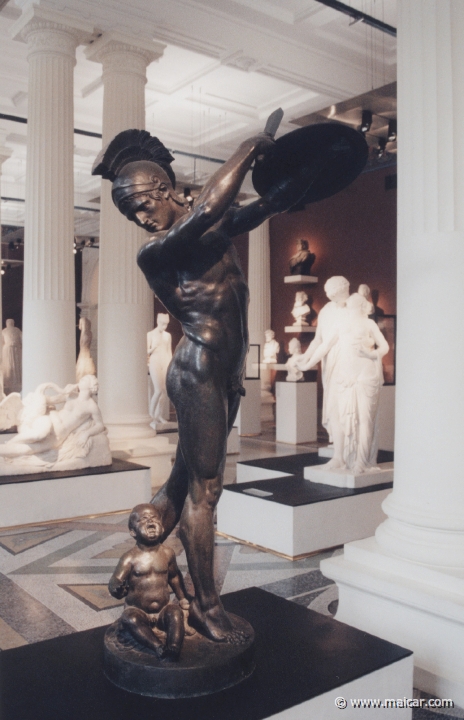|

|
4310: Léon Cugnot 1835-1894: Corybante étouffant les cris de Jupiter enfant. Musée de Picardie, Amiens.
|
|
The CORYBANTES are represented as a kind of
inspired people, subject to Bacchic frenzy, and inspiring
terror at the celebration of the sacred rites by means of
war-dances, noise, cymbals, drums, and arms. They have been
called attendants of Rhea 1,
identified as Cybele, the Mother of the Gods worshipped in
Phrygia, and guardians of
Dionysus 2 in his growing days.
It is also told that the CORYBANTES, came from Colchis
(today Georgia in the Caucasus), and were given as armed
ministers to Rhea 1 by the
TITANS. The CORYBANTES are inclined to dancing and to religious frenzy, and worship the Mother of the Gods with orgies. The CORYBANTES are sometimes said to have been expelled from their country by their father Socus 2, and to have ruled the Euboean battalions that joined Dionysus 2 in his war against
the Indians.
CORYBANTES have been called the following: Acmon 3, Cyrbas, Damneus, Idaeus 3, Melisseus 3, Mimas 6, Ocythous 3, Prymneus 2, and Pyrrhichus.
The CORYBANTES, the CABIROI, the
DACTYLS and the TELCHINES are sometimes represented as identical with the CURETES, and sometimes as kinsmen of one another (see below).
Additional Notes
The CABIROI
The CABIROI are the children of Hephaestus and
Cabiro, a Thracian woman, daughter of Proteus 2, the seer who is known as the Old Man of the Sea. The surviving names of the CABIROI are Alcon 5 and Eurymedon 5. Three of them (the others are not named) are said to be the children of Cadmilus, who is also a son of Hephaestus and
Cabiro. But those who said that the CORYBANTES are
sons of Zeus and Calliope,
also say that the CORYBANTES and the CABIROI are
identical. The NYMPHS CABIROIDES are the daughters
of the CABIROI, though three of them are said to be
the children of Hephaestus and
Cabiro. The CABIROI were honored in Imbros, Lemnos, and also in
different cities of the Troad.
DH.1.23.5; Hdt.3.37; Nonn.14.19; Strab.10.3.21.
The CURETES
The CURETES, often identified with the
CORYBANTES, guarded the infant Zeus, clashing their spears
on their shields in order that Cronos might not hear the
child's voice. They could have been descendants of
the DACTYLS. Their life
is the tune of pipes, and the noise of beaten
swords. They have been described as flute-players,
and wearing brazen shields. They have been called
the rearers and protectors of Zeus, having been summoned
from Phrygia to Crete by Rhea 1. Offspring of Gaia.
Apd.1.1.7, 1.8.3, 2.1.3; Cal.Ze.51; DH.2.70.3ff.; Dio.5.60.2, 5.65.1; Eur.Bacc.120; Nonn.13.155; Vir.Geo.4.151; Strab.10.3.11, 10.3.19.
The TELCHINES
About the TELCHINES it is said that, together
with Caphira, nurtured Poseidon, whom Rhea 1 committed as a babe
to their care. Of the nine TELCHINES who lived in Rhodes, those who
accompanied Rhea 1 to Crete, and reared Zeus in his youth were named CURETES (see above). However, others have said that the TELCHINES are the offspring of Poseidon and Thalatta (the Sea). The TELCHINES were the first inhabitants of Rhodes, which was then
called Telchinis, and are said to have come to this
island from Cyprus, though being originallt from Crete. Those TELCHINES who
came from the city of Ialysus were flooded by Zeus, but others, foreseeing the catastrophe, left the island and were scattered. One of them, Lycus 12, went to Lycia and built beside the river Xanthus the temple of Apollo Lycius. Other TELCHINES, like Damnameneus 2 and Scelmis, are said to have joined Dionysus 2 in his Indian campaign. Some have considered the TELCHINES to be
malignant sorcerers, who poured the water of the
infernal river Styx mixed, as some say, with
sulphur, upon animals and plants with the purpose
of destroying them. But others have said that this
bad reputation has its origin in the Envy of rival workmen,
caused by the excellence of the TELCHINES'
workmanship. For they are said to have been the
first to fashion statues of gods, those who made Cronos' sickle, and to
have discovered other arts as well, being the first
to work iron and brass.
Dio.5.55.1-2; Nonn.14.36; Stat.Theb.2.274;
Strab.10.3.19.
The DACTYLS (see link).
|